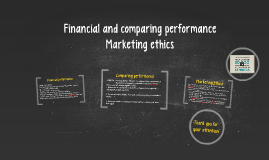Financial Performance
Transcript: Financial Performance Analyzing Key Metrics and Trends Historical Performance Analysis Trend Analysis Techniques Historical performance analysis involves reviewing past financial data to identify trends, patterns, and anomalies over different periods. Key metrics such as revenue growth, profit margins, and expenditure are scrutinized to gauge the company's financial health and operational efficiency over time. Trend analysis techniques, including linear regression and moving averages, are employed to forecast future financial performance based on historical data. They help in detecting patterns and making predictions that inform budgeting, resource allocation, and strategic planning. Analyzing Financial Trends Key Performance Indicators (KPIs) Understanding financial trends is crucial for evaluating a company's historical performance, identifying patterns, and making informed business decisions. This section delves into historical performance analysis, trend analysis techniques, and comparative analysis to enhance strategic insights. Profitability Ratios Key Performance Indicators (KPIs) are crucial metrics that provide insights into a company's financial health. Understanding these ratios enables better decision-making and strategic planning. Profitability ratios evaluate a company's ability to generate profit relative to its revenue, operating costs, and equity. Key examples include the Gross Profit Margin, Net Profit Margin, and Return on Equity (ROE), which indicate financial efficiency and success. Summary of Findings Comparative Analysis Conclusion and Recommendations Solvency Ratios The analysis reveals that consistent monitoring of key financial metrics directly correlates with improved profitability and strategic decision-making. Profitability ratios indicate a strong potential for growth, while liquidity and solvency ratios reflect stable financial health, ensuring the company can meet its short-term and long-term obligations. This section consolidates the insights gained from the analysis of financial performance, emphasizing key findings and strategic actions for future success. It underscores the importance of ongoing financial monitoring to sustain growth and profitability. Liquidity Ratios Comparative analysis compares a company's financial metrics against industry standards or competitors. This assessment reveals strengths and weaknesses, helping stakeholders understand the company's market position and competitiveness, leading to strategic decision-making. Solvency ratios measure a company's ability to meet its long-term debts and obligations. Critical ratios such as Debt to Equity and Interest Coverage Ratio inform stakeholders about financial leverage and risk management. Liquidity ratios assess a company's ability to cover its short-term obligations. Key metrics like the Current Ratio and Quick Ratio measure the relationship between liquid assets and liabilities, providing insights into financial stability. Strategic Recommendations Future Financial Performance Monitoring Establishing a routine for monitoring financial performance through quarterly reviews and updates is critical. Integrating advanced analytics and benchmarking against industry standards will facilitate proactive adjustments, ensuring that the organization remains agile and responsive to market changes. Efficiency Ratios To enhance financial performance, it is recommended to implement a robust financial planning process that incorporates regular forecasting and budgeting. Additionally, focusing on cost-control measures and investing in high-return projects can significantly improve overall profitability and competitiveness in the market. Efficiency ratios gauge how effectively a company utilizes its assets and liabilities to generate sales and maximize profits. Ratios like Asset Turnover and Inventory Turnover highlight operational efficiency and resource management. Importance of Forecasting Forecasting is essential for businesses as it aids in budgeting, forecasting revenue, and planning for growth. Companies that utilize forecasting are better positioned to respond to market changes and make data-driven decisions, ultimately enhancing profitability. Overview of Key Metrics Methods of Forecasting Income Statement Components Key components are revenues, expenses, and net profit. Revenues reflect sales generated, expenses indicate costs incurred, and net profit reveals the company's remaining profit, critical for investors and stakeholders. Key metrics in financial performance include net profit margin, return on assets (ROA), and return on equity (ROE). These indicators offer insights into profitability, efficiency, and overall financial health of the business. Financial Forecasting Key methods of financial forecasting include qualitative techniques such as surveys and expert opinions, and quantitative methods like historical data analysis and statistical models. Each method has its strengths and is chosen based on data

















